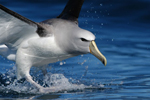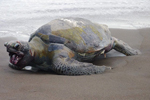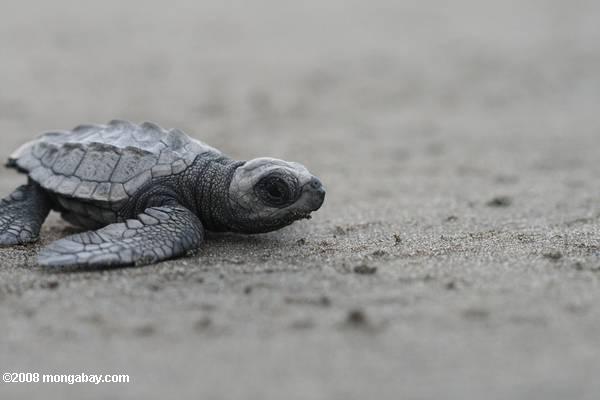Bycatch, a side-effect of commercial fishing in which non-target species are accidentally caught, is linked to severe population declines in several species. Sea turtles are particularly impacted by small-scale coastal gillnetting practices, in which large nets are deployed and indiscriminately snag anything of a certain size that attempts to swim through them. However, that may soon change. A new study in Biology Letters—conducted by researchers at the Joint Institute for Marine and Atmospheric Research at the University of Hawaii, Ocean Discovery Institute, Comison Nacional Areas Protegidas and Pacific Islands Fisheries Science Center—announces the development of new technology that reduces bycatch rates by utilizing ultraviolet light.
“Bycatch of threatened species such as sea turtles and marine mammals is often a major concern because some bycatch rates are so large that it threatens the entire population of those species,” said John Wang, one of the authors of the study. “Gillnets are one of the most ubiquitous forms of fishing around the world. It is relatively low cost, easy to deploy, and offers a livelihood for many peoples in coastal communities. Gillnet fishing is often the most non-specific type of fishing – that is – it often associated with high rates of bycatch.”
Baby sea turtle on a Costa Rican beach. Photo by Rhett A. Butler / mongabay.com
To counter increasing bycatch rates, bycatch reduction technologies (BRT) have been created based on an animal’s sensory cues and behavior. The scientists discovered that loggerhead (Caretta caretta) and leatherback (Dermochelys coriacea) sea turtles are sensitive to ultraviolet light wavelengths while many commercially important fish species have UV-absorbing compounds in their eyes that filter UV light. The scientists found that it is possible to exploit this disparity in visual capabilities to develop BRTs to prevent sea turtle bycatch.
“Understanding the sensory physiology of sea turtles and fish species helped us in choosing to use UV illumination,” said Wang. “By using UV light, we have a used a selective means of communicating to sea turtles but not to fish.”
According to a study, the scientists deployed 11 nets specifically designed to emit UV wavelengths, and found that illuminating gillnets with UV light reduced sea turtle capture rate while having no effect on the total target catch rate for commercial fisheries. In addition, the scientists note that visual-based BRTs can effectively reduce other types of bycatch; nets that are more visible also pose less risk to seabirds. At the time of this writing, testing of illuminated nets has begun in fisheries in Peru, Southern Baja California, Brazil and Indonesia.
 A female leatherback seaturtle camouflaging her nest on a beach in Suriname. Photo by Tiffany Roufs / mongabay.com
A female leatherback seaturtle camouflaging her nest on a beach in Suriname. Photo by Tiffany Roufs / mongabay.com
The study recognizes that simply providing illuminated gillnets will not completely solve the problem, and that engagement and education of fishermen is equally important.
“One major aspect of our work is to work closely with fishermen in the fishing community,” said Wang. “They are part of all of experiments from the beginning. The fishermen are very supportive; they do not want to catch animals that have no value because it wastes their time, damages their gear, and creates bad press for them.”
Wang J, Barkan J, Fisler S, Godinez-Reyes C, Swimmer Y. 2013 Developing ultraviolet illumination of gillnets as a method to reduce sea turtle bycatch. Biol Lett 9: 20130383. http://dx.doi.org/10.1098/rsbl.2013.0383
Related articles
Above the ocean: saving the world’s most threatened birds

(11/01/2012) A life on the ocean is a perilous one for any bird. They must expend energy staying aloft for thousands of miles and learn to be marathon swimmers; they must seek food beneath treacherous waves and brave the world’s most extreme climates; they must navigate the perils both of an unforgiving sea and far-flung islands. Yet seabirds, which includes 346 global species that depend on marine ecosystems, have evolved numerous strategies and complex life histories to deal with the challenges of the sea successfully, and they have been doing so since the dinosaur’s last stand. Today, despite such a track record, no other bird family is more threatened; yet it’s not the wild, unpredictable sea that endangers them, but pervasive human impacts.
Featured video: tuna industry bycatch includes sea turtles, dolphins, whales
(01/16/2012) A Greenpeace video, using footage from a whistleblower, shows disturbing images of the tuna industry operating in the unregulated waters of the Pacific Ocean. Using fish aggregation devices (FADs) and purse seine nets, the industry is not only able to catch entire schools of tuna, including juvenile, but also whatever else is in the area of the net.
California celebrates its inaugural Pacific Leatherback Conservation Day with sobering reality

(10/15/2013) On an isolated beach in Bird’s Head Peninsula, Indonesia, a female leatherback turtle shuffles out of the ocean and onto the shore, ready to lay her eggs. Under the cover of night she excavates a hole in the sand, depositing anywhere from 80 to 100 eggs inside. Using her flippers she flicks sand over the eggs, hiding them from potential predators. Then, shuffling away, she returns to the turquoise waters ready to make an 8,500-mile journey across the Pacific Ocean to the California coast.
Are sea turtles responsible for lower fish catches in India?

(08/29/2013) Fishing communities on Agatti Island in Lakshwadeep, India, blame their reduced fish catch on green turtles; according to them, green turtles chomp their way through the seagrass beds lining the shallow reef waters that are essential for fish to breed. This leads some in the community to clandestinely kill sea turtles and destroy their nests.
Eighty sea turtles wash up dead on the coast of Guatemala

(08/27/2013) An assortment of marine animals and birds reside along the black volcanic sand beaches of Guatemala’s Pacific coast, but lately both residents and visitors on the southeast beaches of the country have observed a tragic event – the stranding of dead sea turtles.
Eighty dead sea turtles have been recorded since the first week of July.
